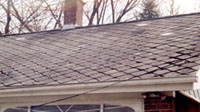|
Asbestos Information What Is Asbestos? What Is Asbestos?Asbestos is a mineral fiber found in rocks, of naturally occurring silicate minerals that can be separated into fibers. There are several kinds of asbestos fibers, all of which are fire resistant and not easily destroyed or degraded by natural processes. The fibers are strong, durable, and resistant to heat and fire. They are also long, thin and flexible, so that they can even be woven into cloth, because of these qualities, asbestos has been used in thousands of consumer, industrial, maritime, automotive, scientific and building products.
![[picture of asbestos containing pipe insulation]](https://www.ainspect.com/CMContent/Asbestos_Testing/asbestos-pipe.jpg) The above photo shows a typical asbestos insulated heating pipe found in older homes. During the twentieth century, some 30
million tons of asbestos have been used in industrial sites, homes,
schools, shipyards and commercial buildings in the United States.
There are several types of asbestos fibers, of which three have been
used for commercial applications: (1) Chrysotile, or white asbestos,
comes mainly from Canada, and has been very widely used in the US. It
is white-gray in color and found in serpentine rock. (2) Amosite, or
brown asbestos, comes from southern Africa. (3) Crocidolite, or blue
asbestos, comes from southern Africa and Australia.
Do
All People Exposed To Asbestos, Develop Asbestos Related Disease? Some of the other common
asbestos-containing products are insulating cement, insulating block,
asbestos cloth, gaskets, packing materials, thermal seals, refractory
and boiler insulation materials, transite board, asbestos cement pipe,
fireproofing spray, joint compound, vinyl floor tile, ceiling tile,
mastics, adhesives, coatings, acoustical textures, duct & pipe
insulation for heating, ventilation and air conditioning (HVAC)
systems, roofing products, insulated electrical wire and panels, and
brake and clutch assemblies.
In most cases, asbestos containing materials are best left
alone.
When it is necessary to disturb
asbestos, you should contact a licensed asbestos contractor. You can
also obtain a copy of Asbestos in the Home published by the
U.S. Consumer Products Safety Commission (800-638-2772) which
discusses the situation and makes recommendations. Remember, do not
dust, sweep, or vacuum particles suspected of containing asbestos
fibers. |
 People who have frequently worked with
asbestos (such as plumbers, building contractors or heating
contractors) often are able to make a reasonable judgment about
whether or not a material contains asbestos on a visual inspection.
Many professional home inspectors also can make a reasonable visual
judgment. To be absolutely certain, an industrial hygienist would have
to make the identification.
People who have frequently worked with
asbestos (such as plumbers, building contractors or heating
contractors) often are able to make a reasonable judgment about
whether or not a material contains asbestos on a visual inspection.
Many professional home inspectors also can make a reasonable visual
judgment. To be absolutely certain, an industrial hygienist would have
to make the identification.